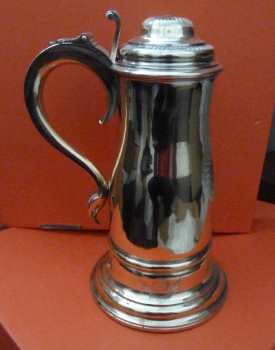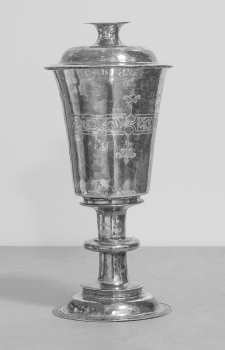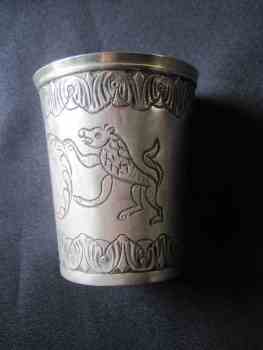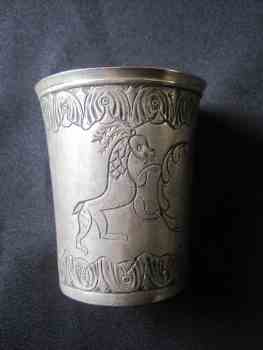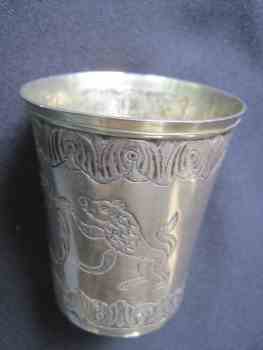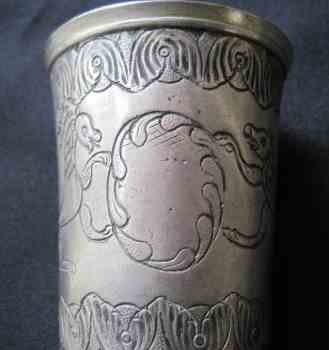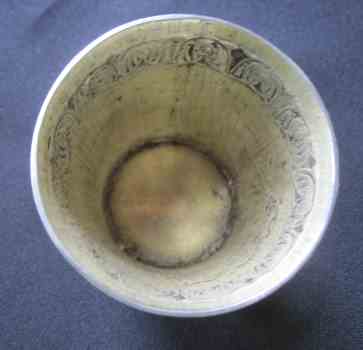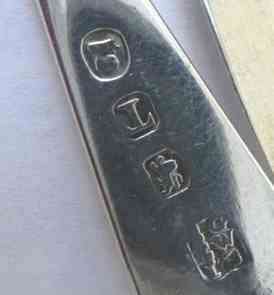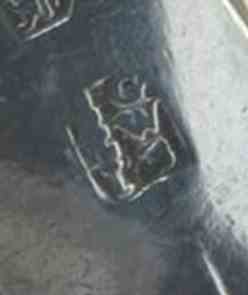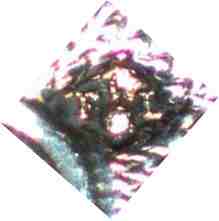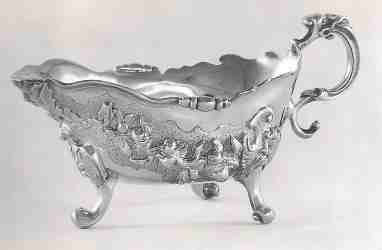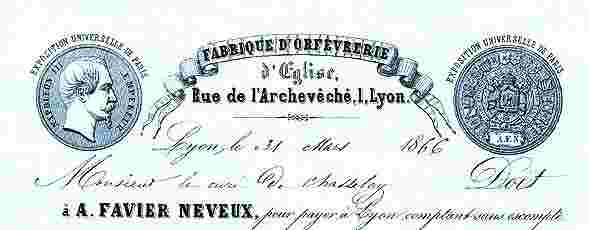
Robert Massart presents:
Favier Family: Three Towns and 150 Years of Silversmithing

La Famille Favier: Trois Villes et 150 Ans d'Orfèvrerie

The name Favier has a long and charged history, starting
approximately 1824 and ending in 1976. The Favier silversmiths
were famous manufacturers of ecclesiastical silver works such as
chalices, ciborium, monstrance, patens, cruets and plates. Their
work can be seen in many cathedral treasuries. At least 179
works are inventoried and protected today in the name of
historical monuments in the Ariège department.
Religious silversmithing was profoundly innovated by the Favier
family by excerpting on medieval sources and later by joining
movements of symbolism and Art Nouveau......
click here
 click here
click here

Welcome to new ASCAS members:
Endre Biro - Romania
Andre Delicata - Malta
Eric Stefano Rijnders - The Netherlands
Louise Tomkins - England UK
DORSET'S CHURCH TREASURE
TELLING THE STORY OF CHRISTIANITY THROUGH THE CENTURIES
An exhibition of Ecclesiastical Silver at Dorset County
Museum, Dorchester from 13 October 2014 to 18 April 2015.
In Christian churches, the act of communion has always been
the most important religious ceremony. Traditionally
congregations wished to have the very best communion vessels
that they (or their richest members) could afford. As a result
Dorset churches have a wealth of beautiful and rare collections
of silver, some of it so valuable that it has to be stored in
bank vaults. A new exhibition at Dorset County Museum provides a
rare opportunity to see some of the finest pieces in both Dorset
and the UK.
The new temporary exhibition in the Museum's Victorian Gallery
tells the story of Christianity for over 2000 years - from
Pre-Reformation times to the present day. Crafted by
world-famous silversmiths, the pieces include the Coombe Keynes
Chalice from the Victoria and Albert Museum in London - an
object of huge national importance.
Dorset appears to have had a strong Christian community as far
back as Roman times. An example of this tradition is a Roman
spoon from Dorchester with the "fish" Christian cipher.
By the early 16th century England was a devoutly Christian
country and only the Priest was normally allowed to take full
communion. He drank wine from a wide mouth vessel called a
chalice and took bread, in the form of an unleavened wafer, from
a small plate called a paten. Pieces of church silver from this
period in England are rare and in Dorset only three pieces
survive. All of these can be seen in the exhibition including
the Coombe Keynes Chalice which has been said by the Victoria
and Albert Museum to be one of the finest in the country.
Many consider the 18th century as the greatest period for church
and domestic silver and Paul de Lamerie is generally accepted as
the greatest silversmith of the time; some say of all time. On
display is one of the three silver-gilt communion sets made by
de Lamerie for Dorset churches. There is also a letter, dated
June 1937, which records instructions on how to clean the silver
as directed by Paul de Lamerie, himself.
In the mid-1800s a new Anglo Catholic movement wanted to bring
more powerful emotional symbolism and energy to the Church. More
elaborate church interiors were introduced and the design of
communion ware moved to a more mediaeval style. The chalice on
show from St Peter's church Parkstone is a fine example of the
richness and ebullience of this style. The chalice is inlaid
with semi-precious stones and has a diamond cross on the front,
reputed to be from necklace owned by the donor.
"This exhibition contains some of the finest pieces of church
silverware in the country," said Jon Murden, Director of Dorset
County Museum. "We are grateful to all the Dorset parishes which
have loaned items for us to display. We hope many people will be
able to see these hidden treasures before they go back into safe
storage."
In addition to silver chalices, patens and flagons, there are
other fascinating items including a very rare bread knife for
cutting communion bread. Accompanying the exhibition is a
booklet describing Dorset's ecclesiastical silver and the
development of Christianity in Dorset since the 4th century. The
exhibition will be formally opened by the Bishop of Sherborne,
Dr Graham Kings, and will run at Dorset County Museum from 13
October 2014 to 18 April 2015.
The award-winning Museum is open Monday to Saturday, 10am to 5pm
until the end of October when it closes daily at 4pm. For
further information contact the Museum on 01305 262735 or visit
www.dorsetcountymuseum.org.
David Beaumont writes:
...Dear Giorgio, do you or any of your members have any ideas
about the date and origins of this unmarked beaker?
It is hand raised with gilding inside and there are two engraved
stylised or mythical beasts supporting the central cartouche.
Thank you for any forthcoming help or suggestions.
David Beaumont
Frank W Wilson writes:
...I append a picture of two spoons I have recently purchased
but find that my information on Makers Marks is not good enough
to identify the lower of the two spoons where the left hand side
of the Mark is completely obliterated and only a GW is obvious.
Do you think you could help to identify the maker?
Your help would be wonderful.
Frank W Wilson
The mysterious hallmark belongs to Samuel Godbehere, Edward
Wigan & James Boult (S.Godbehere & Co), mark entered 15.3.1800,
see my website at
http://www.silvercollection.it/englishsilvermarksXS2.html
Giorgio Busetto
Riccardo Bonardi writes:
...I'm unable to identify the maker on a French silver pill box.
It is hallmarked 'Minerva' and 'F ... L' inside a lozenge.
I trust in your help.
Riccardo Bonardi
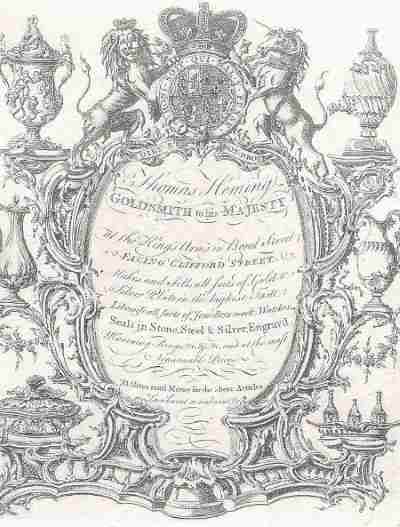 |
This month ASCAS presents an ancient trade card of:
THOMAS HEMING
GOLDSMITH to his MAJESTY
"At the King's Arms in Bond Street
Makes and Sells all Sorts of Gold &
Silver Plate in the highest Taste
Likewise all Sorts of Jewellers work, Watches
Mourning Rings and at the most
Reasonable Prices"
|
"A WORD per MONTH"
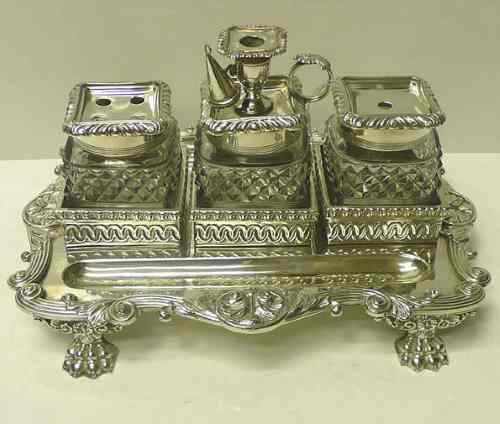
|
INKSTAND
A desk stand supporting a variety of writing
accessories.
It is made in various forms, but the basic examples are:
- an oblong box with hinged lid, holding inkpot and a
pounce-pot. Sometimes a sealing-pot case and a wafer-pot
are added. Quill pens are held on a drawer or on a
compartment on the back;
- a tray, upon which rest inkpot, pounce-pot, sand-box,
quill-pot, wafer-box. Sometimes the inkpot is surmounted
by a taperstick and a hand bell.
The tray has various forms (rectangular, oval,
triangular) and is supported by four feet (in the form
of ball or paw). The inkstand has usually a guard ring
or suitable recesses in which to place the writing
accessories....
more
|
"A SILVERSMITH per MONTH"
|
|
PAUL DE LAMERIE
The parents of Paul De Lamerie
(Paul Souchay de la Merie and Constance le Roux) had
fled from France to the Netherlands to escape from the
religious persecutions following the revocation of the
edict of Nantes by Louis XIV.
Paul was born in the Netherlands (Hertogenbosch) in 1688
and in 1691 the family transferred to London.
In 1703 Paul was apprenticed to Pierre Platel (a
Huguenot silversmith) obtaining his freedom in 1712.
Pierre Platel had great influence on the career of Paul
de Lamerie from which he learnt the art of working in
silver and gold and to him he owed in great measure his
future fame.
Paul de Lamerie entered his first mark at the Goldsmiths'
Hall in 1712 (letters LA surmounted by a crown with a
fleur-de-lis below, in the style current at the time
among Parisian silversmiths).....
more
|
"A CREST per MONTH"
HOARE-COLT
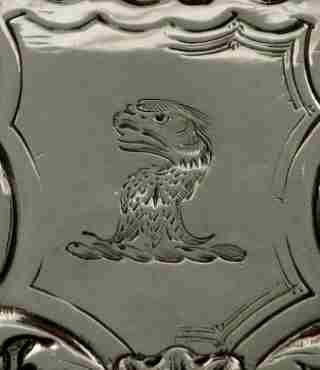
|
The crest of Hoare-Colt Bart.,
Stourhead, Wiltshire
An eagle's head, erased
The crest was found in a silver tankard hallmarked
London 1737, maker Humprey Payne
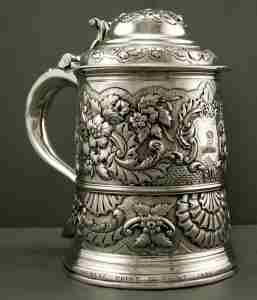
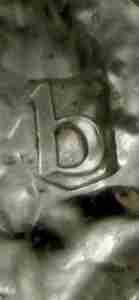
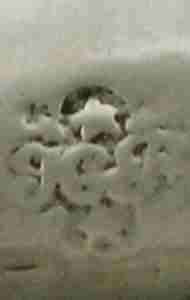 |
Closing our NOVEMBER 2014 edition of ASCAS Newsletter I hope
you have appreciated its content.
Your comments, suggestions and advice will be of great help.
My thanks to David Beaumont, Riccardo Bonardi, Robert Massart
and Frank W Wilson for their precious contributions.
Giorgio Busetto
Secretary
DISCLAIMER AND PRIVACY POLICY
ASCAS is a community of people having a common
interest in antique silver.
It is a non-profit association without commercial links.
Membership is open to whomever has a true interest in
this subject matter.
ASCAS has no real property and no fees are requested nor
accepted from members.
ASCAS keeps in touch with its members only through
periodical newsletters, e-mails and web-site updating
and ignores and is not responsible for any other
activity pursued by its members.
Likewise, ASCAS is not responsible for opinions,
evaluation and images displayed, and in any form
published or supplied for publication, by its members
who, in any case, maintain the property of their works
and assure the respect of national and international
legislation about Intellectual Property.
ASCAS does not have the full addresses of its members (only
town, country and e-mail address are requested for
membership).
ASCAS handles and protects with care its members' e-mail
addresses, will not disclose the addresses to third
parties, will use this information only to reply to
requests received from members and for communications
strictly related to its activity.
These rules are expressly accepted by submitting the
membership request.
|
|
 newsletter
# 126 November 2014
newsletter
# 126 November 2014








